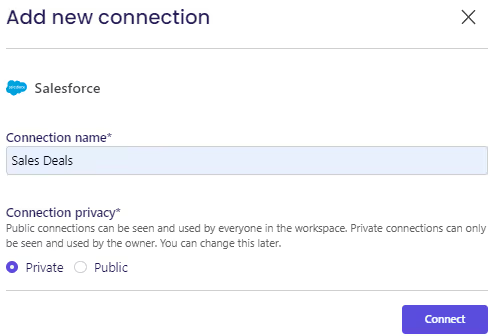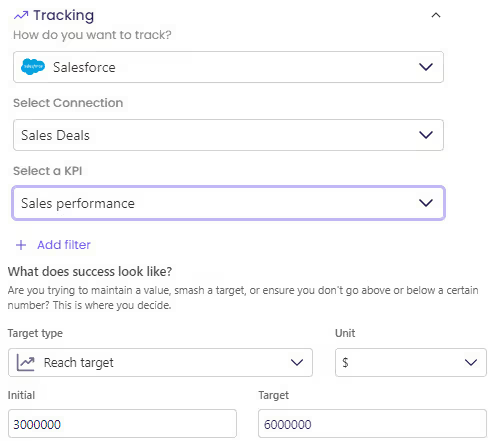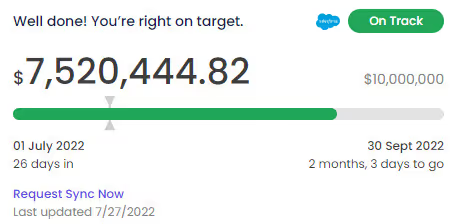
Salesforce
Zapier is a powerful integration platform that seamlessly connects thousands of tools with each other, including Cascade!
All you need to get started is a Cascade Premium or Enterprise subscription and a Zapier account.

Salesforce
Trigger


Cascade Action


Salesforce
Action
How does the integration work?
Using Zapier, Cascade allows you to update several important pieces of information from any app avalible on Zapier, such as:
- Update Action Current Progress
- Update Measure Current Value
- Update Measure Historical Value
Note: Cascade’s Zapier integration is currently in Beta. We are actively working on adding new Capabilities, Triggers and Actions. Stay tuned for more soon!
What is
Salesforce
?
Tracking lead response time? How about sales activity? Average contract value? Salesforce is an incredibly powerful CRM, with applications in marketing, sales, commerce, service, and IT. Use our Salesforce integration to gain real-time visibility on how your team’s Salesforce data fits into your strategic plan. With our integration, you won’t have to worry about data entry errors or setting silly reminders to update your data; your sales data will automatically update your Cascade Goals. Reduce or even eliminate the time you spend on repetitive data entry and focus on what you do best!
Ready to get started with Zapier?
If you already have a Cascade Premium or Enterprise subscription and you’re ready to get creative, you get started now with Zapier!
How to setup Salesforce in Cascade
Salesforce-Cascade integration is supported only for Essentials and Enterprise+ tiers.
Salesforce is an incredibly powerful CRM, with applications in marketing, sales, commerce, service, and IT. Whether you need to know the sales performance, or the revenue generated from a sales lead, or any number of insights from Salesforce, we've got you covered with just a few clicks. For example, when you need to track measures like "Revenue from deals won", "Sales performance in APAC", "Sales by lead source", and so on, which is hosted in Salesforce will be automatically pulled, and displayed in Cascade.
Use our Salesforce integration to gain real-time visibility on how your team’s Salesforce data fits into your strategic plan. With our integration, you won’t have to worry about data entry errors or setting silly reminders to update your data; your sales data will automatically update your Cascade Goals. Reduce or even eliminate the time you spend on repetitive data entry and focus on what you do best.
Before you establish the connection, these pre-requisites must be met:
- A 'Measure' that is associated to your 'Objective' in the plan that you created in Cascade, and want to link to Salesforce.
- An Essentials or Enterprise+ or unlimited tier Salesforce account.
Once you ensure that these are met, you can start integrating with Salesforce. This can be done in two ways:
- From Integrations > Metrics & measures.
- Click Add Tracking against the 'Measure' from the Plan Details area of the Planner page.
How to integrate Salesforce with Cascade?
Click Metrics and KPIs tab from your Integrations page. Click Connect to start integrating. In the Connection Name field, enter the name and choose whether it will be a private or shared connection.

A private connection can be used only by the person who created it, while a public/shared connection can be seen and used by everyone in your account for automating measure's progress.
Click Connect. On successful authentication, the connection is added.
You've successfully integrated Salesforce. You can now start managing your measures, and track with preset KPIs and Salesforce's insights.
These instructions use the "Lightning" version of Salesforce. If you are using the "Classic" version, some details may differ. For convenience, you might try to toggle on the Lightning version or upgrade your browser to support Lightning.
How to track progress with Salesforce-Cascade integration?
When you click Add Tracking, the Edit Measure window opens. Under the Tracking section, select Salesforce from the drop-down list.

Once you select Salesforce, you will see a list of related fields beneath it.

- Select Connection: Click Add new connection to add a new connection, or select an existing connection from the drop-down list.
- Select a KPI: Choose a KPI from the drop-down list.
- (Optional) Add filter: Click Add filter to choose relevant insights for the KPIs that you need here at Cascade. If the chosen KPI is Sales performance, the insights that you can fetch are - sales performance by representatives, account, campaign, or lead source. And if the KPI is Closed Activities, you can get insights filtered by representative or type (email, meetings, task, etc.).
- Under What does success look like area, select the Target type, Initial and Target values that you wish, and finally choose the Unit from the list. If you wish to customize the tracking by "maintaining" specific targets, then select Maintain between or Maintain above or Maintain below from the Target type dropdown. See Customize Tracking for your Measures for details.
Click Save. You have now successfully enabled the tracking. Once hooked up, it'll automatically update with the most current value, and given the update frequency they’ve selected, bring in historical values for the chosen KPI.

The sync happens every one hour, and you can click Refresh Sync Now to poll the data immediately.
How to use Zapier to connect Salesforce with Cascade?
Though we've a native integration with Salesforce, not all the KPIs are pulled in with that connection. If you wish to bring some other values from Salesforce like pipeline, sales cycle, sales activity, and so on, you can integrate Salesforce with Cascade through Zapier. See How to Use Zapier with Cascade to establish a connection between Zapier and Cascade.
- Create the measure in Cascade, and choose tracking as Zapier from the list, define the initial and target values, and click Save.
- A modal pops-up and takes you to the zap interface. Choose the apps as Salesforce and Cascade, and select the trigger and action.

- Sign in to your Salesforce account, and choose the Salesforce environment to connect Zapier to your Salesforce account.
- You've already chosen the trigger in the second step, but you can change it now if you wish.
- Test the trigger to check if the value that needs to be mapped to Cascade is pulled in.
- Now, connect to your Cascade account, and select the workspace, plan, and the relevant measure in Cascade.
- Choose the measure value from the triggered values obtained from the Salesforce event.
You can also run a query to fetch a dataset from Salesforce to decide on what values you need to bring into Cascade. To understand the different triggers from Salesforce, troubleshooting, and other related help information with the Salesforce-Zapier workflows, please search for "Salesforce" in the Zapier Help Center.
FAQs
I'm getting a "Connection does not work" error message.
In this case, the best option is to delete your connection and reconnect. Go to Integrations and use the trash icon to delete the connection. Follow the preceding instructions to set up a new connection. See How to delete a connection section in Collaborate and Automate with Integrations for details.
What Salesforce subscription do I need?
You need to have an enterprise or unlimited tier subscription since Salesforce restricts access to its API for certain subscriptions. This means that you'll only be able to use our Salesforce integration if it's included in your subscription. Ask your Salesforce admin or support representative to check if you have access.
What happens if I change the Salesforce password used in a public or private connection or how can I change/adapt the Cascade - Salesforce connection in case of a password update?
Navigate to Integrations > Metrics & KPIs > Salesforce, and click Manage. It'll list all the connections with Salesforce in your workspace. From the three dots against your connection, click Refresh connection, and follow Salesforce's instructions to reconnect your Salesforce account with Cascade.
Can I connect my login multiple times?
No. Connections are based on logging in to a Salesforce account.
You can create only one connection per Salesforce login in Cascade. This means that you can authenticate your username in Salesforce only once for your whole Cascade instance. If you want to share your connection with other members in Cascade, make sure your connection is set to Shared.










